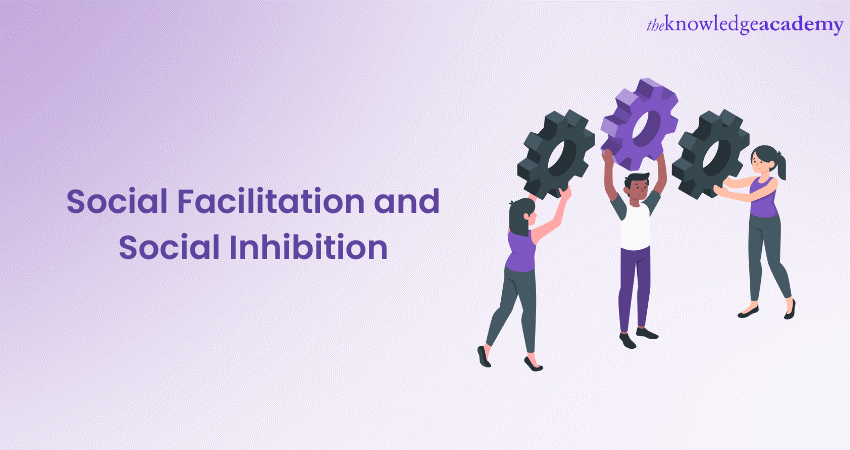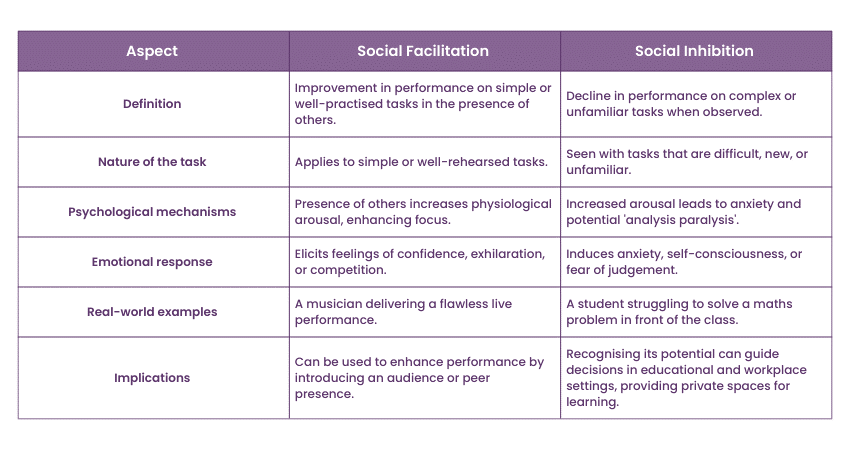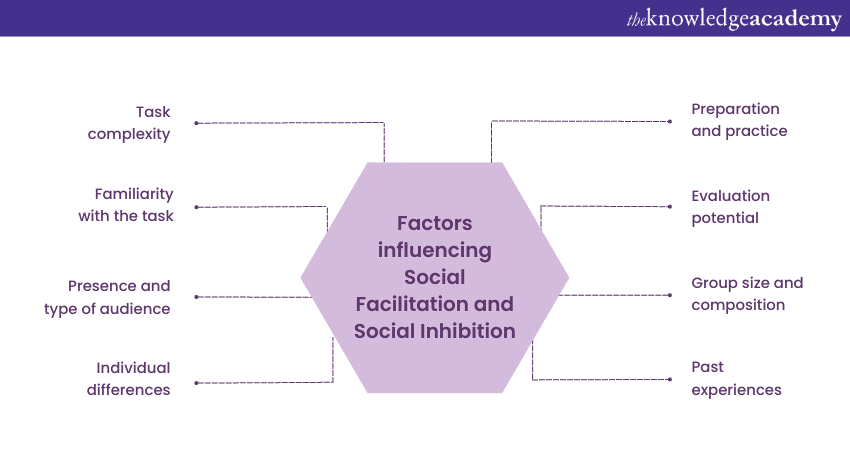We may not have the course you’re looking for. If you enquire or give us a call on +45 89870423 and speak to our training experts, we may still be able to help with your training requirements.
Training Outcomes Within Your Budget!
We ensure quality, budget-alignment, and timely delivery by our expert instructors.

In the vast arena of social psychology, understanding how the presence of others influences our performance is both fascinating and essential. The concepts of Social Facilitation and Social Inhibition take centre stage in this exploration, offering insights into the contrasting ways we react when observed.
Though the concepts sound similar, their approach to understanding the circumstances is different. Therefore, it’s crucial to understand the difference between the two. Dive into this blog to unravel the intricacies of the concepts of Social Facilitation and Social Inhibition, as well as the factors that sway their effects.
Table of Contents
1) What is Social Facilitation?
2) What is Social Inhibition?
3) Social Facilitation vs Social Inhibition: Key differences
4) Factors influencing Social Facilitation and Social Inhibition
5) Conclusion
What is Social Facilitation?
Social Facilitation refers to the phenomenon where an individual's performance on tasks improves when undertaken in the presence of others. Initially observed by Norman Triplett in 1898 with cyclists, he noticed they raced faster when competing against others compared to racing alone.
This phenomenon isn't limited to physical tasks; it also applies to cognitive ones. Essentially, the mere presence of an audience can boost performance, particularly on well-practised or simple tasks. However, the mechanism behind this effect relates to increased arousal, which can be beneficial for familiar tasks but detrimental for complex or unfamiliar ones.
What is Social Inhibition?
Social Inhibition is a psychological phenomenon where an individual's performance on certain tasks deteriorates in the presence of others. Contrary to Social Facilitation, where observation enhances performance on familiar tasks, Social Inhibition emerges when the task is complex or unfamiliar. The added pressure from being watched can make individuals feel self-conscious or anxious, leading them to second-guess their actions or decisions.
Essentially, the fear of negative evaluation or potential mistakes, especially when faced with judgemental observers, can inhibit optimal performance. This fear can make individuals less efficient or effective than they might be in a more private setting.
Ready to boost your team's productivity? Sign up for our Facilitation Skills Training and embark on a journey towards more effective team leadership today!
Social Facilitation vs Social Inhibition: Key differences
Both Social Inhibition and Social Facilitation are foundational concepts that explain the myriad ways in which the presence of others can influence an individual's performance. While they might seem like two sides of the same coin, there are critical distinctions between them. Let’s delve deeper into these differences.

Definition
Social Facilitation refers to the improvement in performance on simple or well-practised tasks when they are carried out in the presence of others. Essentially, people tend to do better at things they're already good at when they're being watched.
On the contrary, Social Inhibition highlights the decline in performance on complex or unfamiliar tasks when conducted in front of others. In this scenario, observation becomes a hindrance rather than a boost.
Nature of the task
Social Facilitation typically occurs with tasks that are simple or well-rehearsed. When individuals are proficient in a particular task, the presence of others can serve as a motivating factor, often due to increased arousal.
Social Inhibition is most likely to be observed in situations where the task at hand is difficult, new, or unfamiliar to the individual. The added pressure of being observed can make individuals second-guess themselves, leading to poorer outcomes.
Psychological mechanisms
In Social Facilitation, the presence of others often increases physiological arousal. When it comes to tasks an individual is adept at, this arousal can streamline focus, thus improving performance.
In Social Inhibition, increased arousal from being watched can be detrimental when it comes to unfamiliar tasks. The individual may become overly self-conscious, experience anxiety, or even encounter 'analysis paralysis'—overthinking to the point of inaction.
Emotional response
Social Facilitation is often accompanied by positive emotions, like heightened confidence, exhilaration, or even a sense of competition. However, social Inhibition is more likely to induce negative feelings, such as anxiety, self-consciousness, or fear of judgement. The individual might doubt their capabilities or become overly concerned about potential mistakes.
Real-world examples
A real-world example of Social Facilitation would be a seasoned musician delivering a flawless live performance. It can also be an athlete setting a personal best in a competition with an audience.
On the contrary, a relevant real-life example of Social Inhibition would be a student struggling to solve a complex math problem on the board in front of the class or an individual hesitating in a group brainstorming session due to fear of saying something "stupid".
Implications
Leveraging an understanding of Social Facilitation can be beneficial in scenarios like training sessions, competitive sports, or public speaking events (for those experienced). It can be a tool for enhancing performance by introducing an audience or peer presence.
Recognising the potential for Social Inhibition can guide decisions in educational settings, workplace training or any situation where individuals are faced with new challenges. Providing private spaces for learning or practice might mitigate the negative effects of Social Inhibition.
Unlock your social potential: Join our Social Skills Masterclass today!
Factors influencing Social Facilitation and Social Inhibition
Social Inhibition and Social Facilitation are pivotal in understanding human performance in group settings or under observation. While the basic premise of each phenomenon is clear, various factors determine whether an individual's performance will be facilitated or inhibited. Here's a detailed look at those influencing elements. Let's explore these factors in detail:

Task complexity
Simple tasks often lead to Social Facilitation since they rely on automatic processing, and increased arousal tends to enhance performance. On the contrary, complex tasks are more prone to Social Inhibition, as they require controlled processing. In these situations, heightened arousal can disrupt concentration or lead to overthinking.
Familiarity with the task
Well-practised tasks can trigger Social Facilitation since the individual has mastered the required skills and can perform even with added arousal. Unfamiliar tasks increase the likelihood of Social Inhibition because the individual is already grappling with learning, and the added pressure from observers can be overwhelming.
Presence and type of audience
Passive observers can sometimes lead to Social Facilitation as they boost arousal without adding the stress of evaluation. On the other hand, judgemental observers – especially experts or authority figures, can heighten the fear of negative evaluation, leading to Social Inhibition.
Individual differences
People with high self-esteem or confidence or who inherently believe in their abilities are more likely to experience Social Facilitation. On the other hand, people with high self-consciousness or anxiety often fear negative evaluation, making them more susceptible to Social Inhibition.
Past experiences
Positive reinforcement or previous successful experiences under observation can bolster confidence, paving the way for Social Facilitation. On the other hand, previous failures in front of others can heighten the fear of repetition, leading to Social Inhibition in subsequent attempts.
Group size and composition
Small, familiar groups can foster Social Facilitation due to the comfort and predictability they offer. On the contrary, large or unfamiliar audiences can amplify the pressure to perform, making Social Inhibition more probable.
Conclusion
In the intricate dance of human behaviour, Social Facilitation and Social Inhibition shine a light on the profound impact of social presence on individual performance. Recognising the factors that enhance or hinder our actions in communal settings is crucial. By harnessing this knowledge of Social Facilitation and Inhibition, we can create environments that foster growth, confidence, and optimal performance, irrespective of the observing eyes.
Boost your team's productivity and drive success with our industry-leading Industry Training!
Frequently Asked Questions
Upcoming Business Skills Resources Batches & Dates
Date
 Facilitation Skills Training
Facilitation Skills Training
Fri 20th Dec 2024
Fri 17th Jan 2025
Fri 28th Mar 2025
Fri 23rd May 2025
Fri 27th Jun 2025
Fri 8th Aug 2025
Fri 17th Oct 2025







 Top Rated Course
Top Rated Course



 If you wish to make any changes to your course, please
If you wish to make any changes to your course, please


